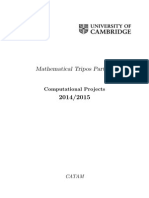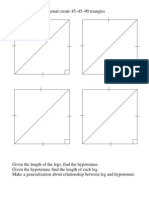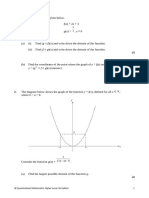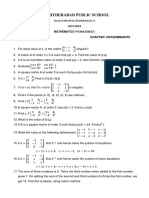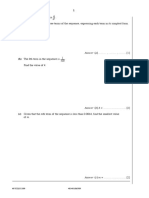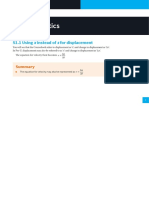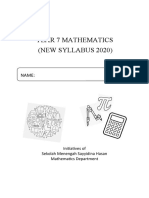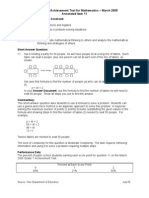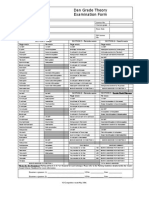Cambridge O Level: Mathematics (Syllabus D) 4024/22
Cambridge O Level: Mathematics (Syllabus D) 4024/22
Uploaded by
Aiza ZeeCopyright:
Available Formats
Cambridge O Level: Mathematics (Syllabus D) 4024/22
Cambridge O Level: Mathematics (Syllabus D) 4024/22
Uploaded by
Aiza ZeeOriginal Title
Copyright
Available Formats
Share this document
Did you find this document useful?
Is this content inappropriate?
Copyright:
Available Formats
Cambridge O Level: Mathematics (Syllabus D) 4024/22
Cambridge O Level: Mathematics (Syllabus D) 4024/22
Uploaded by
Aiza ZeeCopyright:
Available Formats
Cambridge O Level
MATHEMATICS (SYLLABUS D) 4024/22
Paper 2 May/June 2023
MARK SCHEME
Maximum Mark: 100
Published
This mark scheme is published as an aid to teachers and candidates, to indicate the requirements of the
examination. It shows the basis on which Examiners were instructed to award marks. It does not indicate the
details of the discussions that took place at an Examiners’ meeting before marking began, which would have
considered the acceptability of alternative answers.
Mark schemes should be read in conjunction with the question paper and the Principal Examiner Report for
Teachers.
Cambridge International will not enter into discussions about these mark schemes.
Cambridge International is publishing the mark schemes for the May/June 2023 series for most
Cambridge IGCSE, Cambridge International A and AS Level and Cambridge Pre-U components, and some
Cambridge O Level components.
This document consists of 9 printed pages.
© UCLES 2023 [Turn over
4024/22 Cambridge O Level – Mark Scheme May/June 2023
PUBLISHED
Generic Marking Principles
These general marking principles must be applied by all examiners when marking candidate answers. They
should be applied alongside the specific content of the mark scheme or generic level descriptors for a question.
Each question paper and mark scheme will also comply with these marking principles.
GENERIC MARKING PRINCIPLE 1:
Marks must be awarded in line with:
the specific content of the mark scheme or the generic level descriptors for the question
the specific skills defined in the mark scheme or in the generic level descriptors for the question
the standard of response required by a candidate as exemplified by the standardisation scripts.
GENERIC MARKING PRINCIPLE 2:
Marks awarded are always whole marks (not half marks, or other fractions).
GENERIC MARKING PRINCIPLE 3:
Marks must be awarded positively:
marks are awarded for correct/valid answers, as defined in the mark scheme. However, credit is given for
valid answers which go beyond the scope of the syllabus and mark scheme, referring to your Team
Leader as appropriate
marks are awarded when candidates clearly demonstrate what they know and can do
marks are not deducted for errors
marks are not deducted for omissions
answers should only be judged on the quality of spelling, punctuation and grammar when these features
are specifically assessed by the question as indicated by the mark scheme. The meaning, however,
should be unambiguous.
GENERIC MARKING PRINCIPLE 4:
Rules must be applied consistently, e.g. in situations where candidates have not followed instructions or in
the application of generic level descriptors.
GENERIC MARKING PRINCIPLE 5:
Marks should be awarded using the full range of marks defined in the mark scheme for the question
(however; the use of the full mark range may be limited according to the quality of the candidate responses
seen).
GENERIC MARKING PRINCIPLE 6:
Marks awarded are based solely on the requirements as defined in the mark scheme. Marks should not be
awarded with grade thresholds or grade descriptors in mind.
© UCLES 2023 Page 2 of 9
4024/22 Cambridge O Level – Mark Scheme May/June 2023
PUBLISHED
Mathematics Specific Marking Principles
1 Unless a particular method has been specified in the question, full marks may be awarded for any correct
method. However, if a calculation is required then no marks will be awarded for a scale drawing.
2 Unless specified in the question, answers may be given as fractions, decimals or in standard form. Ignore
superfluous zeros, provided that the degree of accuracy is not affected.
3 Allow alternative conventions for notation if used consistently throughout the paper, e.g. commas being
used as decimal points.
4 Unless otherwise indicated, marks once gained cannot subsequently be lost, e.g. wrong working
following a correct form of answer is ignored (isw).
5 Where a candidate has misread a number in the question and used that value consistently throughout,
provided that number does not alter the difficulty or the method required, award all marks earned and
deduct just 1 mark for the misread.
6 Recovery within working is allowed, e.g. a notation error in the working where the following line of
working makes the candidate’s intent clear.
Abbreviations
cao correct answer only
dep dependent
FT follow through after error
isw ignore subsequent working
oe or equivalent
SC Special Case
nfww not from wrong working
soi seen or implied
© UCLES 2023 Page 3 of 9
4024/22 Cambridge O Level – Mark Scheme May/June 2023
PUBLISHED
Question Answer Marks Partial Marks
1(a)(i) p = 97.2[0] 4 B1 for p = 97.2[0]
q = 66.3[0] B1FT for q = 66.3[0] or q = 163.5 – their p
r = 34 B1FT for r = 34 or r = their q ÷ 1.95
s = 1.14 B1 for s = 1.14
1(a)(ii) 35.2 or 35.24 to 35.25 2 325 240.30
M1 for 100 oe or
240.30
325
100 [– 100] oe
240.30
1(b)(i)(a) 98 2 9520.70
M1 for 360 or
34974
360
9520.70
34974
After 0 scored, SC1 for answer 27.2[2… %]
1(b)(i)(b) 4468.9[0] 2 46 34974
M1 for 34974 or 46 or
360 360
46
9520.7
their 98
1(b)(ii) 33 500 2 100 4.4
M1 for x 34974 soi
100
2(a) 5p + 8×75 = 910 or B1
5p = 910 – 8×75 or
5p 75
8 9.1 0 or
100 100
5p 75
9.1 0 8
100 100
62 B2 M1 for correctly rearranging their equation to p
= ….
After 0 scored, SC1 for answer [$]0.62
2(b) 3c(2a – 9) or –3c(9 –2a) 2 B1 for 3c(2a – 9) seen and spoilt or
final answer final answer 3(2ac – 9c) or c(6a – 27)
2(c) mn 2 2
final answer
6 mn 2
B1 for seen and spoilt or answer with two
6
1
of , m and n2
6
© UCLES 2023 Page 4 of 9
4024/22 Cambridge O Level – Mark Scheme May/June 2023
PUBLISHED
Question Answer Marks Partial Marks
2(d) 1 2
5y 5y 2
or oe
3 3 5y 5y
final answer B1 for seen and spoilt or x 2
3 3
2(e) 15 4 B3 for 56.8k – 56.5k = 56.5 – 52 or better
56.8k 52
or B2 for 56.5 oe
k 1
or B1 for 56.8k or 56.5(k + 1) oe seen
Alternative method
B3 for 56.8x – 56.5x = (56.5 – 52)×56.8 or
better
x x 56.5 52
or B2 for oe
56.8 56.5
x x 52
or B1 for k or 56.5 oe seen
56.8 k 1
3(a)(i) 135 1
3(a)(ii) 24 2 180 n 2 360
M1 for 165 oe or [n =]
n 180 165
oe
or B1 for exterior angle = 15
© UCLES 2023 Page 5 of 9
4024/22 Cambridge O Level – Mark Scheme May/June 2023
PUBLISHED
Question Answer Marks Partial Marks
3(b)(i) Angle AOC = 2x angle at centre is 3
twice angle at circumference B2 for angle AOC = 2x and angle AOC is angle
180 2 x at centre is twice angle at circumference
Angle OAC = 90 x
2 OR
isosceles triangle
B1 for angle AOC = 2x
180 their 2 x
B1 for angle OAC = and
2
isosceles triangle
AOY is diameter. Angle AYC = x B1 for angle AYC = x angles in same segment
angles in same segment are equal are equal
Angle YCA = 90 angles in a B1 for angle YCA = 90 angles in a semicircle
semicircle B1 for angle OAC = 90 – x angles in a triangle
Angle OAC = 90 – x angles in a
triangle
3(b)(ii) 43 2 B1 for angle BCA = 90 – x – 11 oe or
angle OBC = 11 or
angle BDA = 180 – 54 – x oe or
angle ADC = x + 54 oe or
angle ODC = 180 – 2x – 11 oe
or M1 for a correct equation
4(a) 3.2 oe 1
4(b) Correct smooth curve 3 B2FT for 5 or 6 points correctly plotted
or B1FT for 3 or 4 points correctly plotted
4(c) Ruled line y = 1.2 B1
2.5 to 2.7 B1 After 0 scored, SC1 for y = 1.2 soi
4(d)(i) –0.25, 1.25 oe 1
4(d)(ii) Ruled line from (–1, –0.25) to 1
(4, 2.25)
4(d)(iii) x-coordinates where ruled line 1 FT two x-coordinates where their ruled line and
2x their curve cross
4y = 2x + 1 crosses y =
5
4(d)(iv) 2x 2x 1 M1
oe seen
5 4
A = 4, B = –10, C = –5 A2
OR A1 for A correct and either B or C correct or
A = –4, B = 10, C = 5 4×2x – 10x – 5 [=0] or
–4×2x + 10x + 5 [=0] or
Ak, Bk and Ck where k is not an integer
5(a)(i) 2.18 × 107 or 21 800 000 1
© UCLES 2023 Page 6 of 9
4024/22 Cambridge O Level – Mark Scheme May/June 2023
PUBLISHED
Question Answer Marks Partial Marks
5(a)(ii) 8.16 × 105 or 8.164 × 105 cao 1
5(a)(iii) 517 or 5.17 × 102 cao 2 B1 for one correct population density
5(b)(i) 8.45 × 10n final answer 1
5(b)(ii) 1.29 × 102n final answer 2 B1 for 12.9 × 102n – 1 oe seen
6(a) 21 : 10 : 6 final answer 2
B1 for 6300 : 3000 : 1800 oe
6(b) [0]9 50[am] 3 B2 for 75 [minutes] or 1 hour 15 minutes or
1.25 [hours]
figs63
or M1 for
speed
After 0 scored, SC1 for answer 10 44[am] or
10 29[am] or [0]8 53[am]
6(c) 6.75 nfww or 6.752 to 6.753 or 3 B1 for 3005 and 445 seen
67
6
89 their 3005
M1 for
their 445
7(a)(i) 15 1
7(a)(ii) Completed histogram 3 B1 for each bar
After 0 scored, SC1 for 2.4, 1.9 and 0.8 soi
7(a)(iii) 43 1 43
or 0.43 or 43% FT provided their (a)(i) is a
100 85 their(a)(i)
positive integer
7(b)(i) 42.8[0] or 42.78 to 42.79 3
B1 for correct midpoints soi
M1 for
22 15 16 35 24 45 19 55 14 75
22 16 24 19 14
7(b)(ii) 41 is in 40 < m ⩽ 50 so mid-value 1
of 45 would have been used to
estimate the mean which is higher
than the estimated mean oe
8(a)(i) length = 6.8 2 B1 for length = 6.8 or width = 3.4
width = 3.4
After 0 scored SC1 for length = 3.4 and
width = 6.8
© UCLES 2023 Page 7 of 9
4024/22 Cambridge O Level – Mark Scheme May/June 2023
PUBLISHED
Question Answer Marks Partial Marks
8(a)(ii) 10.2 nfww 2 FT 1.5 × their length
30.6 length
B1 for oe or
20.4 length
20.4 length
oe
30.6 length
20.4 30.6 30.6
or M1 for oe or 2 oe
their 6.8 l 6
8(b)(i) 10 10 1 2 75
or or 3 final M1 for 2 8 oe
3 3 3 360
answer
8(b)(ii) 22.7 to 22.9 5
75
82
theirarc length 360
M1 for or oe
2 8
M2 for 82 their r 2 oe
or M1 for 82 – their r2
1
M1 for their r 2 their 7.82
3
9(a) 245 nfww or 244.8 to 244.9 4
B1 for angle BAC = 133
M2 for 1702 952 2 170 95cos(their133)
oe
OR
M1 for
1702 952 2 170 95cos their133 oe
A1 for 60000 or 59950 to 59960
9(b) [0]25 2 B1 for angle CAS = 25 or angle ACN = 25 or
angle NAC= 155
or M1 for 205 – 180
9(c)(i) AD M1
cos(their25) = or
95
AD
sin (90 – their25) = oe
95
86.09[9…] or 86.10 A1
© UCLES 2023 Page 8 of 9
4024/22 Cambridge O Level – Mark Scheme May/June 2023
PUBLISHED
Question Answer Marks Partial Marks
9(c)(ii) 13.6 or 13.62 to 13.63 nfww 4 M2 for AX = 170tan7 oe
AX
or M1 for tan7 =
170
theirAX
M1 for tan […] = oe
86.1
10(a) 10.3 or 10.29 to 10.30 3 Scheme 1:
9
B1 for FH oe
5
M1 for their(–9)2 +their(–5)2
Scheme 2:
3
B1 for [H =] (–3, –4) or [ OH ]
4
M1 for (6 – their(–3)) + (1 – their(–4))2 oe
2
10(b)(i) m (a + kb) or ma + mkb oe 2 B1 for answer ma + …b or …a + mkb
or OC a kb
After 0 scored, SC1 for answer –ma – mkb oe
10(b)(ii) 5 3 3 1
B2 for a – b = b ma + mkb oe
6 5 2
or B1 for BX = BO OX soi or
OX = OB BX soi
© UCLES 2023 Page 9 of 9
You might also like
- Guided Notes Conditional ProbabilityDocument6 pagesGuided Notes Conditional Probabilityapi-441880342No ratings yet
- P1 Chp9 TrigonometricRatiosDocument39 pagesP1 Chp9 TrigonometricRatiosMIhaela CorcheNo ratings yet
- CATAM Part IB Manual 2014-2015Document56 pagesCATAM Part IB Manual 2014-2015SalamanderSylphNo ratings yet
- 11 Statistics1 P62 Summer 2002 2014Document42 pages11 Statistics1 P62 Summer 2002 2014Halim Guru FisikaNo ratings yet
- 4016 Mathematics Topic 1: Numbers and AlgebraDocument7 pages4016 Mathematics Topic 1: Numbers and AlgebraMohammad AshfaqNo ratings yet
- Ict Forward Planning DocumentDocument7 pagesIct Forward Planning Documentapi-451237803No ratings yet
- AdmissionCard - Accenture PDFDocument1 pageAdmissionCard - Accenture PDFVaishali BangadeNo ratings yet
- Paper Plate Intro Unit CircleDocument9 pagesPaper Plate Intro Unit CirclecatheagenNo ratings yet
- PP - Sequences - and - Sums - Markscheme - Ib Maths AA SLDocument19 pagesPP - Sequences - and - Sums - Markscheme - Ib Maths AA SLEmNo ratings yet
- Rearranging The FormulaeDocument14 pagesRearranging The FormulaeKhin Myat MawNo ratings yet
- Paper 1 2024Document14 pagesPaper 1 2024JP Model 14-V5-MKMSNo ratings yet
- Assessor3 StandardisationSetup IB EnglishDocument31 pagesAssessor3 StandardisationSetup IB EnglishMarcela TintinagoNo ratings yet
- AA SL Sequence and SeriesDocument3 pagesAA SL Sequence and SeriesTaksh JethwaniNo ratings yet
- Quadratic EquationDocument1 pageQuadratic EquationEmyRaNo ratings yet
- Quadratic Sequences Questions MMEDocument6 pagesQuadratic Sequences Questions MMEVimalNo ratings yet
- Worksheets - 12TH - 2020-21Document2 pagesWorksheets - 12TH - 2020-21Lalan KumarNo ratings yet
- Multiplying and Dividing FractionsDocument12 pagesMultiplying and Dividing FractionsCarl Jerome CallantaNo ratings yet
- 4024 s02 QP 1Document16 pages4024 s02 QP 1Anas ShahzadNo ratings yet
- Functions Past PapersDocument10 pagesFunctions Past Paperssilagulec9No ratings yet
- Circle TheromsDocument4 pagesCircle TheromsAnuRag SharmaNo ratings yet
- Probability WroksheetDocument6 pagesProbability WroksheetjsarmientodcNo ratings yet
- M23 Extended Mathematics Markscheme English 1Document30 pagesM23 Extended Mathematics Markscheme English 1Tino MabhizaNo ratings yet
- Madasmaths Hard Question PaperDocument6 pagesMadasmaths Hard Question PaperMadalina Novac100% (1)
- Function Transformation QuizDocument7 pagesFunction Transformation QuizGeronimo StiltonNo ratings yet
- Ch. 4. Determinants WorksheetDocument3 pagesCh. 4. Determinants WorksheetBiju Thomas HPS RNo ratings yet
- Sequences PDFDocument40 pagesSequences PDFPeepee PoopooNo ratings yet
- Mathematics HL Paper 1 PDFDocument16 pagesMathematics HL Paper 1 PDFGloria TaylorNo ratings yet
- Screenshot 2023-07-30 at 18.35.41Document24 pagesScreenshot 2023-07-30 at 18.35.41litskar2007No ratings yet
- WORKSHEET - Function Transformation QuestionDocument20 pagesWORKSHEET - Function Transformation QuestionsofiaNo ratings yet
- IGCSE (9-1) Maths - Practice Paper 4HDocument27 pagesIGCSE (9-1) Maths - Practice Paper 4HNooreldeenNo ratings yet
- Flow Chart Questions With AnswersDocument31 pagesFlow Chart Questions With AnswersNaveenraj RajNo ratings yet
- Converting Repeating Decimals To FractionsDocument2 pagesConverting Repeating Decimals To FractionsLiezl AclanNo ratings yet
- 0580 Unit Conversions PPQ v1Document12 pages0580 Unit Conversions PPQ v1MAZIAHDINA BINTI MOHD.KASSIM MoeNo ratings yet
- Chapter 5 INTRODUCTION TO TRIGONOMETRYDocument5 pagesChapter 5 INTRODUCTION TO TRIGONOMETRYLiyakath AliNo ratings yet
- Ass 2015Document15 pagesAss 2015Mark leeNo ratings yet
- VectorsDocument30 pagesVectorsbd87glNo ratings yet
- WORKSHEET - Equation of A CircleDocument23 pagesWORKSHEET - Equation of A Circlesyed saleh nasirNo ratings yet
- Quiz Review Normal DistributionDocument2 pagesQuiz Review Normal DistributionAzka Hamdah (Yr. 22-24)No ratings yet
- Sec 1 MathDocument10 pagesSec 1 MathIshrathNo ratings yet
- Rotation Work Sheets PDFDocument20 pagesRotation Work Sheets PDFAnonymous pQ1Z6R29K9No ratings yet
- Complex Numbers-Assignment 1Document2 pagesComplex Numbers-Assignment 1Mukesh100% (1)
- DeterminantsDocument21 pagesDeterminantsShivani NainNo ratings yet
- Mock Prep Topic 2 Functions-MSDocument24 pagesMock Prep Topic 2 Functions-MSNavam S PakianathanNo ratings yet
- Chap 16Document53 pagesChap 16EveNo ratings yet
- Exponents and Logarithms 2Document20 pagesExponents and Logarithms 2samkelisiwemandisa56No ratings yet
- Ven Diagrams WorksheetDocument8 pagesVen Diagrams WorksheetJohnnot PeagunNo ratings yet
- IGCSE Differenatiation MathDocument22 pagesIGCSE Differenatiation MathRozer oPNo ratings yet
- Assignment 1: Descriptive Statistics (10 Marks)Document4 pagesAssignment 1: Descriptive Statistics (10 Marks)Malik Faizan100% (1)
- 4pm1 01 Que 20230527Document32 pages4pm1 01 Que 20230527zuhayerhossain27No ratings yet
- Pre-U PhysicsDocument182 pagesPre-U PhysicsBobNo ratings yet
- Math Paper 2023Document28 pagesMath Paper 2023naturofarms08No ratings yet
- Sequences and Series IB Problems WorksheetDocument3 pagesSequences and Series IB Problems WorksheetAndrea Mayer LlantoNo ratings yet
- Lines and Angles: English Medium Grade 9Document12 pagesLines and Angles: English Medium Grade 9Sarita KargetiNo ratings yet
- QP G11 MathematicsDocument10 pagesQP G11 Mathematicsmourees karanNo ratings yet
- Chapter 6 - COUNTINGDocument25 pagesChapter 6 - COUNTINGαllєfταωєNo ratings yet
- Quadratic Equation - SheetDocument35 pagesQuadratic Equation - SheetAdarsh YadavNo ratings yet
- Year 7: Number TheoryDocument69 pagesYear 7: Number TheoryDhriti Chowdary GallaNo ratings yet
- Integers Final Assessment TextDocument13 pagesIntegers Final Assessment Textpearl015No ratings yet
- 1exp Topical Assignment 3aDocument2 pages1exp Topical Assignment 3aNidhi Sharma PuranikNo ratings yet
- Sequences Linear Complete Lesson g9Document48 pagesSequences Linear Complete Lesson g9GavalantNo ratings yet
- 1306 FP1 June 2013 - Withdrawn Paper Mark SchemeDocument14 pages1306 FP1 June 2013 - Withdrawn Paper Mark SchemenmanNo ratings yet
- Year 7 Consolidated NotesDocument94 pagesYear 7 Consolidated NotesAiza ZeeNo ratings yet
- Year 7 Geometry 01 Proporties of AnglesDocument3 pagesYear 7 Geometry 01 Proporties of AnglesAiza ZeeNo ratings yet
- Cambridge O Level: Mathematics (Syllabus D) 4024/21Document24 pagesCambridge O Level: Mathematics (Syllabus D) 4024/21Aiza ZeeNo ratings yet
- Year 7 - IndicesDocument6 pagesYear 7 - IndicesAiza ZeeNo ratings yet
- Cambridge O Level: Mathematics (Syllabus D) 4024/21Document8 pagesCambridge O Level: Mathematics (Syllabus D) 4024/21Aiza ZeeNo ratings yet
- Cambridge O Level: Mathematics (Syllabus D) 4024/22Document20 pagesCambridge O Level: Mathematics (Syllabus D) 4024/22Aiza ZeeNo ratings yet
- Cambridge O Level: Mathematics (Syllabus D) 4024/11Document20 pagesCambridge O Level: Mathematics (Syllabus D) 4024/11Aiza Zee100% (1)
- Cambridge O Level: Mathematics (Syllabus D) 4024/11Document7 pagesCambridge O Level: Mathematics (Syllabus D) 4024/11Aiza ZeeNo ratings yet
- Grade 2 Unit 1 Week 1Document8 pagesGrade 2 Unit 1 Week 1Dave & Bella Family FunNo ratings yet
- Tips For Writing A Good ReportDocument2 pagesTips For Writing A Good ReportKelly Low100% (1)
- Information Texts Homework Year 2Document7 pagesInformation Texts Homework Year 2afnaxdxtloexll100% (1)
- Math G6 Q2 Mod11 v2Document35 pagesMath G6 Q2 Mod11 v2robertNo ratings yet
- Cover Letter Sample For The AME StudentsDocument1 pageCover Letter Sample For The AME StudentsTapish KhivensraNo ratings yet
- January 14 Test 2Document6 pagesJanuary 14 Test 2P Olarte ESNo ratings yet
- Art Canada Institute Paul Émile BorduasDocument104 pagesArt Canada Institute Paul Émile Borduasspmonteiro1972No ratings yet
- Lesson Plan n2 HAVE YOU GOT EXTRADocument4 pagesLesson Plan n2 HAVE YOU GOT EXTRAVir UmlandtNo ratings yet
- LFS MA Brochure 2023 02 16 14 22 57Document15 pagesLFS MA Brochure 2023 02 16 14 22 57a36070120No ratings yet
- Ohio Grade 7 Achievement Test For Mathematics - March 2005 Annotated Item 11Document3 pagesOhio Grade 7 Achievement Test For Mathematics - March 2005 Annotated Item 11NiDoh HtooNo ratings yet
- APAC Blockchain Conference 2019Document12 pagesAPAC Blockchain Conference 2019Maine RoyaNo ratings yet
- BCG Findings Recommendations/ Hallazgos y Recomendaciones Escuelas 12nov2014 EspanolDocument25 pagesBCG Findings Recommendations/ Hallazgos y Recomendaciones Escuelas 12nov2014 EspanolEmily RamosNo ratings yet
- Syllabus For Ap 8 S.Y 2020-2021Document25 pagesSyllabus For Ap 8 S.Y 2020-2021Luvina RamirezNo ratings yet
- Dan Grade Theory - Examination Form 2006Document2 pagesDan Grade Theory - Examination Form 2006susername35No ratings yet
- Brochure - 3 RD ProgrammeDocument8 pagesBrochure - 3 RD ProgrammeArchit ChauhanNo ratings yet
- Proposed PSG For ETEEAP 2013Document9 pagesProposed PSG For ETEEAP 2013Zean RimanNo ratings yet
- Glosario Ingles Espanol para Entornos Educativos Del CDEDocument34 pagesGlosario Ingles Espanol para Entornos Educativos Del CDEoscar fernandezNo ratings yet
- Patriotism Policy and Implementation Strategy For Schools in TrinidadDocument43 pagesPatriotism Policy and Implementation Strategy For Schools in TrinidadSharon RamdassNo ratings yet
- It PDFDocument385 pagesIt PDFCosmina UngurNo ratings yet
- Doctor Nurse Bad BehaviorDocument19 pagesDoctor Nurse Bad BehaviorNewfaceNo ratings yet
- NIK L4 U12 TestDocument3 pagesNIK L4 U12 TestNguyen Thanh HuyenNo ratings yet
- Educ 301 Lesson 1 Lesson Plan 1Document3 pagesEduc 301 Lesson 1 Lesson Plan 1api-561365839No ratings yet
- International Mathematical Olympiad Selection ProcessDocument8 pagesInternational Mathematical Olympiad Selection ProcessAakashParanNo ratings yet
- Technical and Vocational Education and Training Issues in Malaysia and Asian Region: Where Do We Go From Here?Document11 pagesTechnical and Vocational Education and Training Issues in Malaysia and Asian Region: Where Do We Go From Here?Kamal JasmanNo ratings yet
- Accomplishment Report-NLC-2023Document3 pagesAccomplishment Report-NLC-2023rochelle nalaNo ratings yet
- SDD Format For StudentsDocument19 pagesSDD Format For StudentsJhardineNo ratings yet
- Reading and Reflecting On TextsDocument44 pagesReading and Reflecting On TextsAnuj KharwalNo ratings yet
- Fee Payment Structure For 2011 OnlyDocument13 pagesFee Payment Structure For 2011 Onlymaga1991No ratings yet


